Where To Hang A Bee House
Think those cute little houses in the backyard are just for birds? Think again! They can be for bees, too. This year, as people become more aware of bee populations declining, bee houses are taking center stage as popular garden decorations. They are charming, valuable habitats for our essential pollinators. After all, we wouldn't be able to live without the bees! Learn how to save the bees simply: Hang a bee house today! Read on.
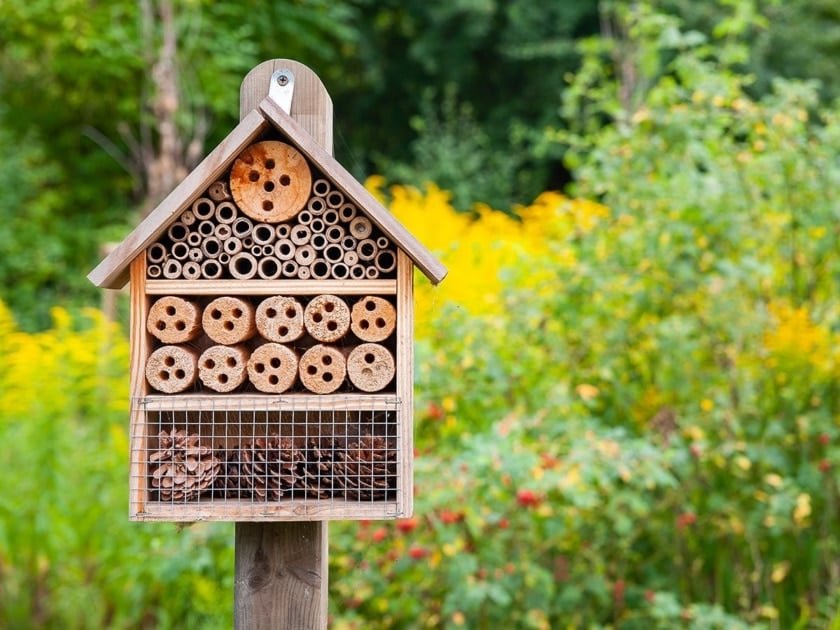
What Are Bee Houses, Exactly?
Bee houses look a lot like bird houses, but instead have little tubes for bees to take up residence and lay eggs. Understanding how these little houses work starts with knowing a bit about the behaviors of native bees. About 80% of bee species prefer to nest in the ground. Another 5% don’t make nests at all. But around15% make homes in cavities like holes in wood or hollow plant cavities. It’s this last 15% that you can help to save with bee houses. Many of these bees are known as leaf-cutter or mason bees. Some of them live in small groups while others prefer to live alone. Solitary, wild bees pollinate more than honey bees do—though honey bees tend to get all the credit! We can thank these non-aggressive bees for pollinating our food sources—from vegetables to nuts, and fruit trees.
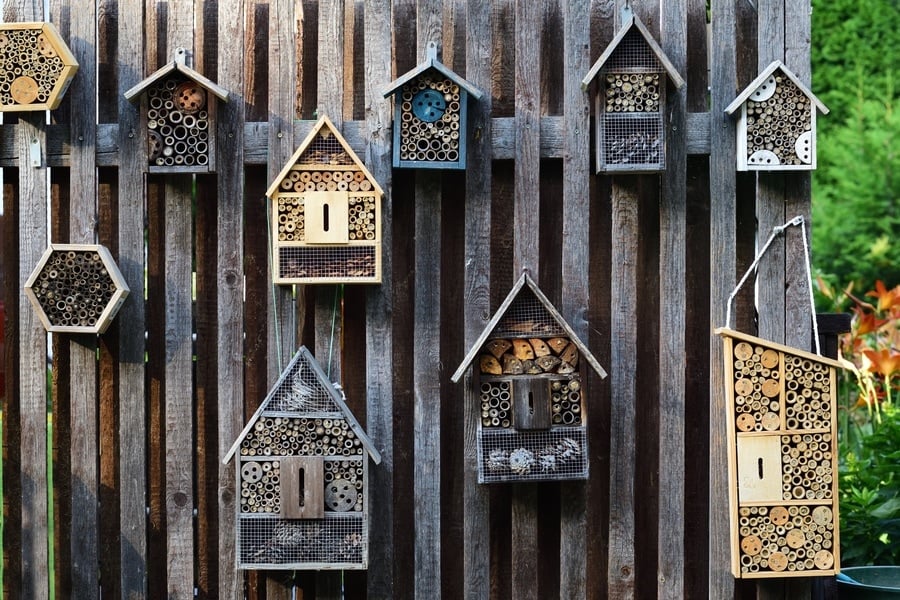
Choosing A Safe Bee House
Unfortunately, the rising popularity of bee houses has encouraged some manufacturers to cash-in on the trend without considering bee safety. There are bee houses on the market that actually pose a threat to bee life. This is why it’s important to keep certain facts in mind while purchasing.
Look for:
- Untreated lumber, non-toxic glue, and/or non-toxic paint.
- Houses with a roof that overhangs the house’s siding by a couple of inches.
- Tubes that are 3-8″ deep, ¼-⅓” in diameter.
- Tubes made from breathable materials that won’t retain moisture. Breathability is the key, since bee houses need to dry out after rain, and nesting bees produce moisture inside the tubes, which needs to evaporate keeping the bees inside healthy. Choose ones that have plenty of airflow surrounding them, such as plant stems, paper straws, wooden straws, or a log with holes drilled in it.
- Removable tubes—for replacement and cleaning.
- * If you use bamboo in your house, make certain it is good and dry before using it. Some bamboo can retain moisture for a long time, which could lead to fungus, etc.
You may construct your own, using the safe materials listed above or you can visit our partners at Kingsyard.
Our partners at Kingsyard offer this wonderful Kingsyard Wooden Mason Bee Butterfly Ladybug House.
Note: Kingsyard is an affiliate of ours, we may make commission off purchases.
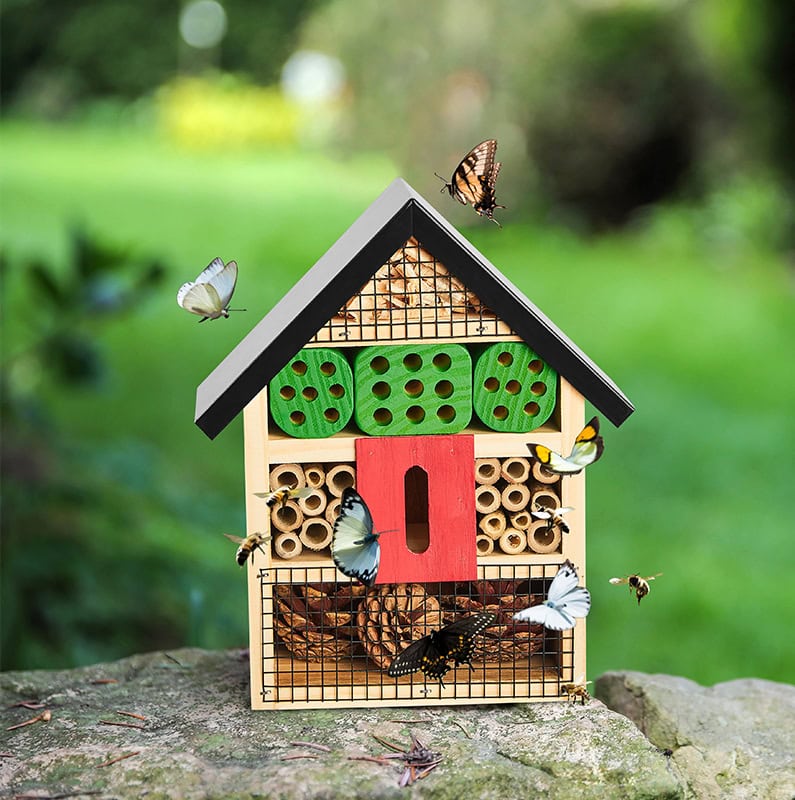
Note: Kingsyard is an affiliate of ours, we may make commission off purchases.
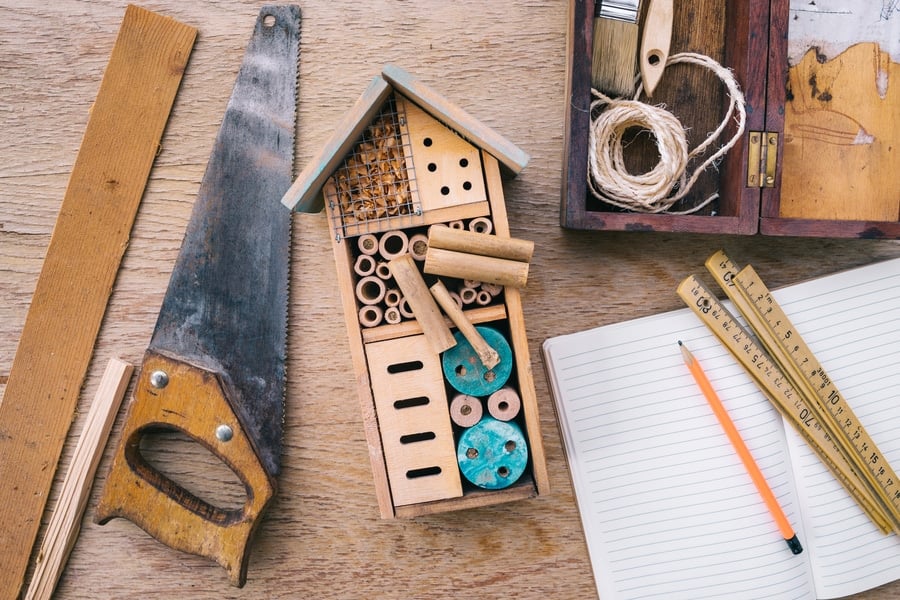
How To Hang A Bee House
Hang a bee house three to six feet off the ground where it will receive direct sunlight every morning (facing south). Place it on something solid—a post, shed wall, or tree. To make your bee house even more attractive to bees, put it next to black-eyed Susan, bee balm, or purple coneflower. Stay away from bird feeders or ponds.
Warning: bee houses make an easy target for birds who eat insects. Use metal netting or a screen around the bee house to keep the birds out.
When Will Bees Move into My Bee House?
Mason bees emerge during early spring when temperatures rise to the 50s and early flowers start to bloom. Leaf-cutter bees show up at the beginning of summer. Bees mate during late spring through early summer and they move into your bee house during early summer.
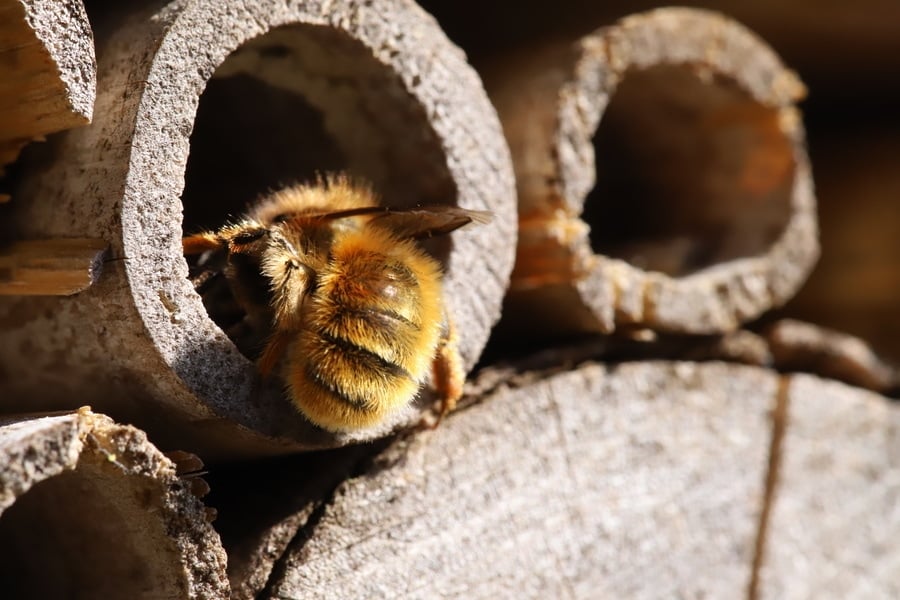
Will Wasps Take Up Residence in My Bee House?
Yes, certain wasps do live in bee houses. Paper wasps may build nests on the structure itself. Mud daubers, another type of wasp, may also make nests out of mud either along the structure or inside the tubes.
The best way to prevent this from happening is to use tubes that are the right diameter for bees. Use tubes with a 5/16” to 3/8” inside diameter to attract larger mason bees and smaller 1/4” diameter tubes to attract leafcutter bees.
Another strategy is to use a “bee condo,” which is a stackable wooden tray with tunnels in it. If you see tubes plugged with something other than mud (for mason bees) or leaves (for leafcutter bees), then that’s indicative of a pest infestation. You can take the blocks apart to scrape out the cocoons inside.
Bee House Maintenance
Bee houses can be left out year-round—especially if you have plugged tubes, which is a sign that fully developed cocoons are nesting inside! If you’re worried about extremely cold temperatures, place the filled tubes in an unheated barn or shed where temperatures stay between 36-39 degrees. In the spring, put the tubes in a cardboard box with an exit hole for the new bees. Once all of them have emerged, wash and brush the tubes with warm soapy water and a mild bleach solution. You may also choose to replace the tubes rather than wash them.
Bee houses are a fun way to attract super pollinators to your garden and keep your buzzing friends happy and healthy.
Here are more suggestions for growing a bee friendly garden!
Do you have a bee house in your yard … or would you consider getting one?
Let us know in the comments below!

Amber Kanuckel
Amber Kanuckel is a freelance writer from rural Ohio who loves all things outdoors. She specializes in home, garden, environmental, and green living topics.


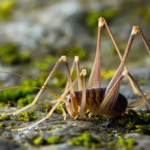
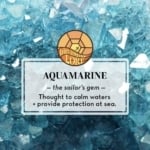


Can bee houses be left outside during Colorado winter where it snows and gets very cold or should it
be moved into unheated barn or should it not be available during winter? Would it be possible
to put it out in early fall?
Are these bee houses solely for bees to reproduce? And what is the difference between these bees and the ones that make honey?
I’m no expert, but from what I’ve read, the houses are to encourage these bees to reproduce in your yard. Carpenter bees are among the native species that pollinate around 15% of our agricultural crops… so we want to encourage them. Honeybees are both pollinators and honey makers. Carpenter bees are really fun to watch and kids love the distinction between them and Bumblebees – which are larger than Honeybees but smaller than Carpenter bees. Carpenter bees have a “shiny hiney” and Bumblebees have a “fuzzy butt” … at 52 this still makes me giggle LOL.
HAHAHA! We love that saying!
I’ve had a bee house all season and I was taking it apart to harvest the cocoons and noticed that the 4 of the tubes were caked with what looks to be a sticky substance possibly honey. It would almost be impossible to remove the cocoons. Shall I just leave them be and just store the trays in the garage for the winter ?
I just bought 2 bee houses I could not find any that were 6 to 8 inches deep anywhere. I have a massive garden and I need all the pollinators I can convince to hang around!
Hi Kate,
The above were suggestions but I’m sure if you have one that’s slightly smaller, it should work. Anything to encourage more pollinators to your garden. Let us know how it goes.
For those who might be concerned about getting stung, most native species are not aggressive and won’t bother you.
What do the bees use the pinecone for ?
Hi Jessica, not sure what or where you see pinecones? Let us know.
There are pinecones literally in the first bee house pictured. I guess you would say in the bee house basement?
Oh you’re right – Sorry Emily. They are just another place for the bees to make a nest. You don’t have to use pine cones. I was looking at our story not the picture.
I would love to have a bee house in my garden, how do I get started.
The pine cones are just an alternative for the bees to make a nest. Just more nooks and crannies.
Thanks Misty!
I am interested in getting a bee house for my garden. i want to provide a safe place for the bee’s and so they can polinate my garden. i know that as long as you don’t hurt them they won’t hurt you but are beneficial for crops so we need to help keep them alive. Since i rent this is the best way I could do it.
Good luck Susan. We do have a link in this article that refers you to a good source for them. Thank you for doing your part to help bees.
Just wondering – the article says the tubes should be 6-8 inches long, but none of the photos (including the “how to make your own”) show tubes longer than about 3 inches (which would be 6 cm).
Hi Paul,
Our article suggests that you use the longer tubes to dissuade wasps from taking up nest in your bee house. The suggested size makes these tubes more appealing to bees rather than wasps. Yes, certain wasps do live in bee houses. Use tubes with a 5/16” to 3/8” inside diameter to attract larger mason bees and smaller 1/4” diameter tubes to attract leafcutter bees.
No Bees no life
I would not, allergies. Not against this, just prefer they be far from where I am.